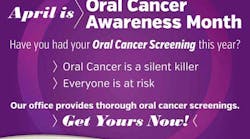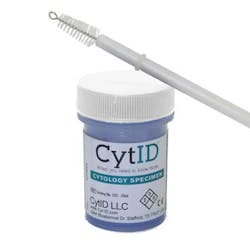Although the increased public awareness of oral cancer made possible by the marketing of screening adjuncts is acknowledged, the implication that such technologies may improve detection of oral cancers and precancers beyond conventional oral examination alone has yet to be scrupulously confirmed, according to one study.(13)
The paper systematically and critically examined the literature associated with current oral cancer screening (2008) and case-finding aids or adjuncts such as toluidine blue, brush cytology, tissue reflectance and autofluorescence. The characteristics of an ideal screening test are outlined in the article and the authors pose several questions for clinicians and scientists to consider in the evaluation of current and future studies of oral cancer detection and diagnosis.
For a link to the six-step screening poster, click here.
There is NO EXCUSE not to perform oral cancer examinations!
References 1. http://oralcancercause.org/oral-cancer-awareness-month/. 2. http://oralcancercause.org/. 3. http://oralcancerfoundation.org/events/oral-cancer-awareness-month.php. 4. Gayar OH, Ruterbusch JJ, Elshaikh M, Cote M, Ghanem T, Hall F, and Siddiqui F. Oropharyngeal Carcinoma in Young Adults-An Alarming National Trend. International Journal of Radiation Oncology Biology Physics. Volume 87, Issue 2, Supplement , Page S436, 1 October 2013. 5. McIlwain WR, Sood AJ, Nguyen SA, and Day TA. Initial Symptoms in Patients With HPV-Positive and HPV-Negative Oropharyngeal Cancer. JAMA Otolaryngol Head Neck Surg. Published online March 20, 2014. doi:10.1001/jamaoto.2014.141 6. Arduino PG, Bagan J, El-Naggar AK, Carrozzo M. Urban legends series: oral leukoplakia. Oral Dis 2013;19(7):642-659. doi:10.1111/odi.12065. 7. https://www.nidcr.nih.gov/OralHealth/Topics/OralCancer/TheOralCancerExam.htm. 8. https://www.nidcr.nih.gov/NR/rdonlyres/480BBD43-DEFB-44CC-B5DF-6CCD17EAA042/0/OralCancerPoster.pdf. 9. http://www.sixstepscreening.org/. 10. https://www.youtube.com/watch?v=448ah5QS4rY. 11. http://www.oralid.com/index/. 12. http://www.cyt-id.com/. 13. Lingen MW1, Kalmar JR, Karrison T, Speight PM. Oral Oncol. 2008 Jan; 44(1):10-22. Epub 2007 Sep 6.









